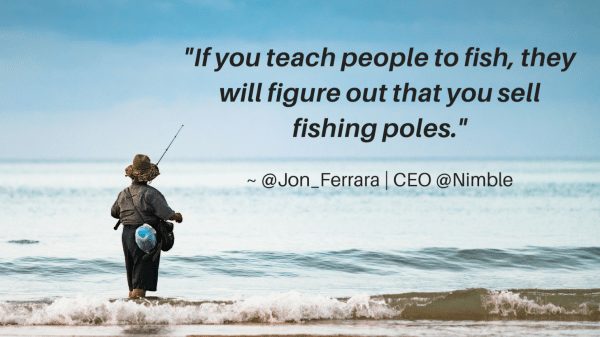We are so excited to share this webinar with you all today. Nimble CEO Jon Ferrara met Jamie Shanks, CEO of Sales For Life years ago at a conference discussing the emergence of social media and its application in business. Jon regards Jamie as someone who practices what he preaches. Additionally, Jon says he remembers noticing Jamie right away because he was wearing an incredibly memorable orange jacket, which made him stand out from the crowd.
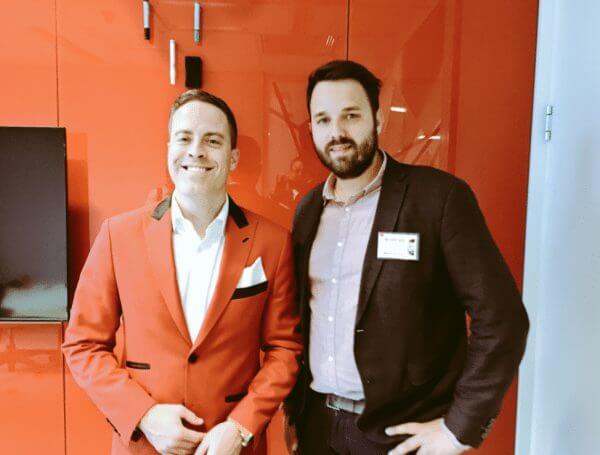
To watch the entire webinar, see the video below.
What differentiates Jamie Shanks from the rest of the social selling pros is the fact that he discusses not only the why but the how of social selling, and how it is measured. He’s helped pioneer the training and the evolution of applying sales to sales professionals at fortune 500 companies globally.
How The World’s Largest Social Selling Training Company Was Created
5 years ago, Jamie shares, he and his business partner were just two guys (and a dog) at a small consulting firm, who recognized that they were failing as sales professionals because they had yet to move from an analog world to a digital one. So, they began using tools such as LinkedIn and Twitter to drive business with prospects. So, over the last 5 years, they’ve created the world’s largest social selling training company as a professional services firm and training platform. Their goal is to recognize that our buyers have evolved into the digital world, and Sales for Life is focused on serving them better.
Social Selling: Why Should It Be a Top Priority for Leaders
Why should we put social selling at the top of our list?
- We Want to Hit Revenue Goals: 78% of social sellers hit their revenue goals in the past year versus 38% of non-social sellers.
- We Want to See an Accelerated Pipeline Growth: Teams that embrace social selling fill pipeline faster 18% more pipeline and 28% faster.
- We want to Receive a Higher ROI: social sellers gain 57% higher ROI from social selling versus 23% using traditional tactics.
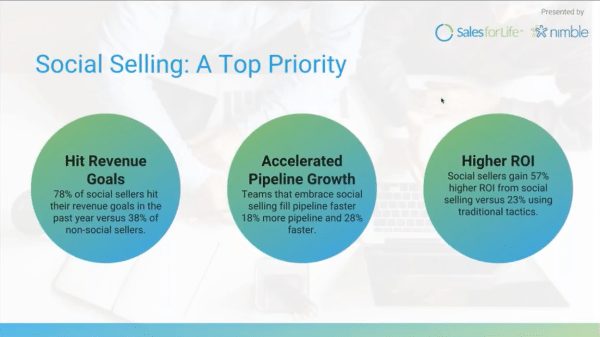
Beyond the Why of Social Selling
Of course, by now, your buyers have likely helped you understand why you need to start social selling. However, you must ask yourself now, how? What are the most effective tactics for social selling?
You must have empirical evidence that success can be driven.
Activity influences sales objectives.
1. How do you prepare to use social selling effectively and measure the ROI
Use the Kirkpatrick Model: all enablement programs/teams use this no matter what you’re training.
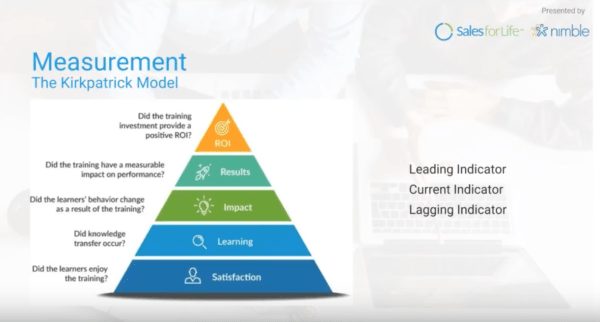
a) Reverse engineer where you want to get to.This is your business outcome.
b) Identify data points that will help you build a business case. You want to look for leading current and lagging indicators.
c) Do my sales professionals want to change? Use surveys, ask them flat out- would you recommend this to other sellers?
d) Test the Sales Professionals on the knowledge. Give them a certification. Also ask them, have they grown their social network around certain accounts? Have they decided which accounts to penetrate based on social proximity?
e) Ensure that the learning is translating into action, which leads to results.
f) You must have a quantifiable scale of new leads, new opportunities, new pipeline coverage and ultimately new sales bookings that are created, influenced and attributed or directly from social sites such as Twitter and LinkedIn.
g) If you know that it is going to take up to a year to build a true business case now you can look to all the baby step “stories” in between and analyze the data points to see where you once were and where you can go from there.
2. What skills do you need to be successful?
You must be willing and able to learn. Those who learn new skills always find more success in their professional lives. Use learning as a litmus test of whos willing to change. Who will walk with you and be willing to change with you and adjust to our digital world?
3. Where do you start in enabling this journey?
Encourage your salespeople to adjust and embrace social selling by letting them know what’s in it for them. People are generally concerned with their own welfare, says Jon, and after all, social selling is really all about building your brand and your network for your own benefit.
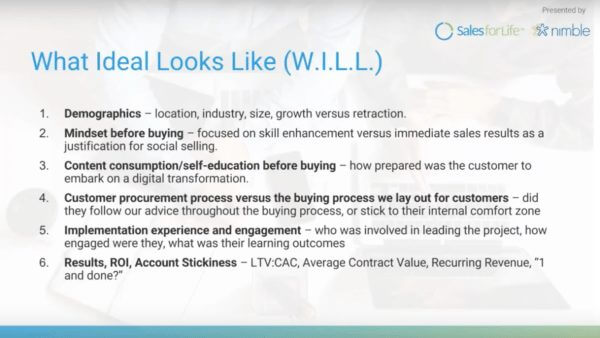
This graphic changed the way we looked at our customer. It helped us to take emotion out of the equation and look strictly at logic. This is an important part of social selling because when a business starts engaging customers and educating them, they are now armed with information to determine whether they are “pushing a rock uphill” or working with the type of people that are willing to work with the business.
Jamie also referenced a statistic he always keeps in the back of his mind—“it is 6 times easier to sell to someone you have already sold to, rather than a random person off the street.” So, it is important to solidify the exact type of customer that fits your target demographic so they remain loyal to your company.
The Role of Sales Leadership in Social Selling
- Team revenue- when sales and marketing come together as one.
- Must be involved in implementation process of movement from analog to digital
The Buying Journey//Sales Cycle of a Lead
There are five different sources of leads.
- Inbound – marketing automation
- Outbound – account-based sales development; our marketing team goes after not those with the largest wallet share but who are in social proximity
- Channel
- Customer referral
- Customer expansion
Regarding this inbound and channel relationship, It is crucial for us to know the customer’s content consumption story. What are they reading? What are they not reading? “When I send the messages, are they actually engaged with them? We use SalesForce for this, as a means for the front end to our engagement process,” says Jamie.
Jamie goes on to share how he loves to use personalized videos on his social media profiles, as well as going on and direct messaging people on LinkedIn and Twitter. It is important to continuously educate and remind the buyer what we offer.
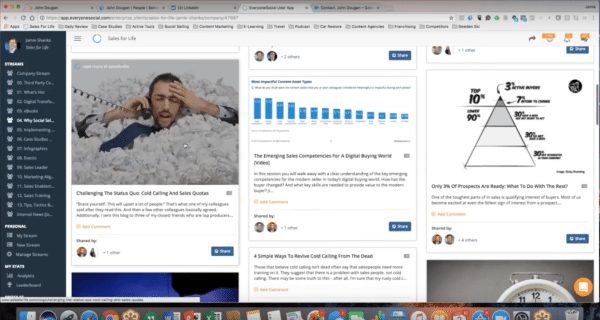
As you can see, Jamie has categorized his potential social media content and messages into sections that reflect the kind of customers he’s going to engage. If he wants to engage someone, he’ll use content from the section “Tips, Tactics, and Tricks” whereas if someone is completely unfamiliar with social selling, he’ll use content from the section, “Why Social Selling?”
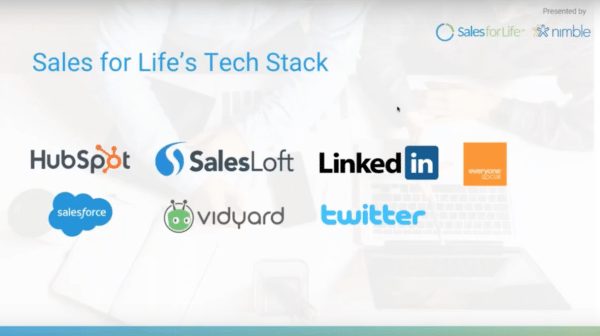
The Nimble Way of Building Your Company Brand
Jon proceeded to share the Nimble customer journey story. Above all, he wants to stress the importance of not the why, but the how of social selling. “I believe that the sales funnel model is archaic. This is not the journey of your buyers anymore, but really more of a pretzel.”
Your market has already been disrupted. Through an unforgiving series of technology revolutions paired with an era of individual empowerment, your customers are not only more informed, their expectations have matured. The “C” change in consumerism has ushered in a genre of connected consumers. As a result, your customers are learning about you or your competitors differently. How they make decisions does not at all follow a linear path. How they are influenced and in turn influence, others are profound in its reach and effect. What was once simplistic, or overly simplistic depending on your point of view, representation of a fluted customer journey is in fact much more dynamic and connected.
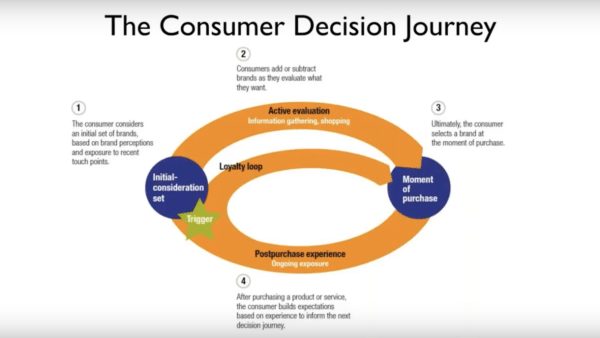
At the end of the day, a company brand is built upon the promises that you make and the experiences that you deliver. As leaders, we should be teaching our customers how to fish, rather than talking about your products and services. If you spend your time teaching your customers about all the benefits of working with you, you are able to continue and solidify the relationships.
Jon shared how at Nimble he uses his philosophy of the 5 E’s of Social Business to grow a potential client pool.
Jon Ferrara’s 5 E’s of Social Business
- Educate with content
Traditional advertising no longer works because people don’t respond to you talking about how great your product is. Instead, you want to become a trusted advisor to potential customers. If you teach someone to fish, it won’t take long for them to realize that you sell fishing poles.

- Enchant by being relevant
The more digital the world becomes, the more human we have to be. Our prospects and customers spot automated messages that were sent to hundreds of others easily. It’s important to take the time to understand your customers, segment them and reach out with an authentic and relevant message. - Engage with authenticity
When somebody talks to you on social media, respond with a relevant and customized message. Research what the person is about, where they are based, what their business is about and respond to them with a personalized message, showing that you care. - Embrace with intent
Saying thank you goes long ways. If you have a customer writing to you with kind words or nice feedback, respond back with thank you and show your appreciation. - Empower your customers
Your goal should be to help other people finding a solution to whatever problem they’re having. Even if your product is not the best fit, try to help as much as you can to point them in the right direction. Use your expertise to be their guide, their trusted advisor.
After selling his first company, GoldMine, creating Nimble, Jon had to get his name out in a market space that had completely evolved.What he did was instead of going out and talking about himself, he identified core prospects and influencers and engaged with them using social media and sharing their content on a daily basis.
After Jon identified the most influential people in the areas of sales, marketing, social media, etc., he started using social media scheduling tools like Buffer to queue the content up, hashtag it appropriately and ideally added some value to their posts by sharing his two cents.
It’s incredibly important to empower your customer-facing business team members to build their brands as well so Jon taught his team members to do the same on their social media profiles. “What happens then is that our accounts get retweets, likes and comments from people looking to become better, smarter, faster at social sales and marketing, “bites” from that person’s audience as well as the person themselves. Then, we nurture the relationships until they become users of our products and ideally storytellers for us. In this day and age, it’s not enough to just engage with customers. We must engage with their influencers as well.”, shares Jon.
The Traditional Consumer Journey vs. The Nimble Customer Journey
Jon explained the problem with the current sales and marketing tech stack which is way too complex, costs too much money. The biggest problem of all is that all the apps that sales and marketing teams usually use don’t even talk to each other.
A standard company uses either MailChimp or Hubspot as their marketing automation systems, then the marketing qualifying leads are moved to company’s CRM. Sales reps now have to go and Google information about their leads to figure out who they are and what their companies are all about.
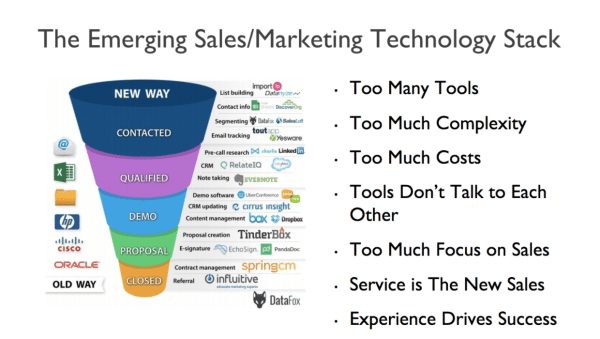
These are just some of the problems that Jon has been trying to solve with Nimble. First, Nimble automatically enriches your contact records for you and via its browser extensions, even allows you to bring a new contact in by simply hovering over the person’s name.
Additionally, Nimble now integrates with over 90+ SaaS applications allowing sales and marketing teams to access all important information about their leads and customers in one place.
Whether you decided to view our webinar or read it here, we appreciate you for tuning in! Of course, we’ve figured that by now you understand the importance of social selling in our modern world. The execution and HOW of social selling is what comes next. With these key pointers from Jamie and Jon, you can harness the power of a variety of apps as well as your personal branding strategy to thrive as a rockstar social seller.

